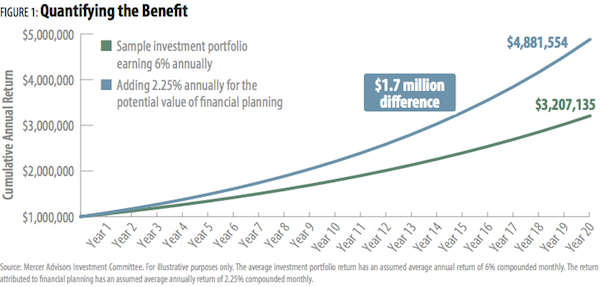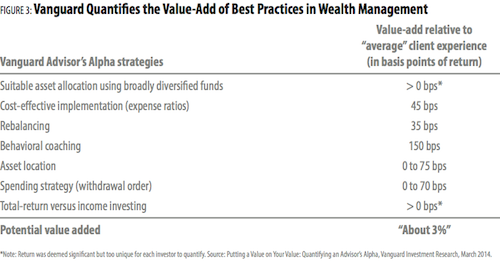The Value of A Holistic Approach to Financial Planning
New research shows a comprehensive approach can boost investment return over the long term.

Since our start in 1985, Mercer Advisors has firmly believed that investors have the most to gain by looking at their financial lives holistically – a mixture of investment advice, comprehensive planning, and life-driven goals. Recent research has put a value on this integrated approach.
Studies by Morningstar and Vanguard show financial advisers who provide wealth management best practices can add significant value beyond market performance. While the findings are hypothetical and are not actual investment results, both sets of research illustrate the value provided by comprehensive financial planning.
Our research shows that investors who follow best practices can earn an additional 1.50% to 3.00% annually. Splitting the difference between these statistics, Figure 1 shows how an additional 2.25% annual return could impact a portfolio over thirty years. (For illustrative purposes only.)
From just $107.88 $24.99 for Kiplinger Personal Finance
Become a smarter, better informed investor. Subscribe from just $107.88 $24.99, plus get up to 4 Special Issues

Sign up for Kiplinger’s Free Newsletters
Profit and prosper with the best of expert advice on investing, taxes, retirement, personal finance and more - straight to your e-mail.
Profit and prosper with the best of expert advice - straight to your e-mail.

The average investment portfolio return has an assumed average annual return of 6% compounded monthly. The return attributed to financial planning has an assumed average annual return of 2.25% compounded monthly.
Morningstar says smart financial planning can translate to 1.5% more in annual average returns. Academics at Morningstar recently coined the term Gamma to define the potential valued added to a portfolio from intelligent financial decisions. In a white paper titled Alpha, Beta and Now….Gamma the authors stated, “Getting Gamma from financial planning best practices offers a much more certain and consistent return than seeking traditional alpha from choosing outperforming mutual funds.” Morningstar identified more than 100 financial planning techniques that can serve as sources of Gamma. They focused on five for their study: total wealth asset allocation, annuity allocation, dynamic withdrawal strategy, liability relative optimization, and asset location & withdrawal sourcing.
Figure 2 shows how properly implementing these value-added strategies can increase returns by as much as 1.59% annually. Of the five strategies, a dynamic withdrawal strategy had the highest potential Gamma. In addition to the five factors, Morningstar found that making informed Social Security claiming decisions could increase returns by another 0.74% annually.

Vanguard finds working with an adviser can add up to 3% in net returns. Vanguard performed a similar study and concluded that financial advisers using wealth management best practices can add “about 3% in net returns” to their clients’ portfolios. Vanguard emphasized that while the value added will vary according to each client’s circumstances and from year to year, “It’s a number that is very real and can reinforce the importance of sticking to a plan and following sound financial advice.”
As detailed in Figure 3, clients can benefit from a qualified adviser who helps them invest in a low-cost, broadly diversified portfolio, maintain their target allocation, and draw down their savings tax efficiently. Successfully implementing all seven strategies can potentially add “about 3%” to an average client experience.

Notably, research finds that advisers can add the most value – “tens of percentage points of value-add, rather than mere basis points” – by helping clients stay the course during bear market lows and avoid performance chasing during market highs.
Best Practices at a Glance
Below are five strategies identified by this new area of best practices research. All of these potential return-enhancing strategies are practiced by Mercer Advisors:
Academic Portfolio Design
Research has found that asset allocation is the biggest driver of a portfolio’s return and risk. Best practice studies conclude that one of the advisor’s primarily responsibilities is to design a properly diversified investment portfolio tailored to each client’s personal needs, goals, and risk profile.
Ongoing Personal Guidance
Studies have shown that average investors often jump in and out of the market, buying at the euphoric highs and panic selling at the distressing lows. Not surprisingly, the returns the average investors earn on their investment portfolios are significantly lower than what the market offered. One of the most valuable services an advisor can provide is to help clients steer clear of money-losing ventures, like trying to time the market or chase returns.
Low-Cost Investing
Research has repeatedly documented that low costs lead to better investment performance. Advisers who implement investment plans with lower-cost funds can add significant value to their clients’ portfolios. Cost-effective implementation is especially important in times of low market returns, when fund expenses erode a higher proportion of returns.
Systematic Portfolio Rebalancing
A good financial adviser keeps the investment plan on track through systematic portfolio rebalancing. Regular rebalancing keeps positions within their target weights and enforces the discipline of buying low and selling high. Without guidance, many investors fail to rebalance their portfolios because it seems counterintuitive to sell winners and buy laggards.
Customized Distribution Planning
Research has shown the benefits of adjusting distributions based on the investment climate and a client’s remaining life expectancy. Advisers utilizing variable withdrawals strategies can help maximize how long their clients’ savings last. Customized distribution planning allows investors to increase spending during good markets, without having to cut back as much in down markets.
David has served as CEO of Mercer Advisors since 2008. He is responsible for the firm’s strategic vision, business plan execution, and organizational structure.
Profit and prosper with the best of Kiplinger's advice on investing, taxes, retirement, personal finance and much more. Delivered daily. Enter your email in the box and click Sign Me Up.

-
 Quiz: Do You Really Know How Social Security Benefits Are Taxed?
Quiz: Do You Really Know How Social Security Benefits Are Taxed?Quiz Social Security benefits often come with confusing IRS tax rules that can trip up financially savvy retirees and near-retirees.
-
 Are You Ready for 65? The Medicare Initial Enrollment Period Quiz
Are You Ready for 65? The Medicare Initial Enrollment Period QuizQuiz Turning 65 soon? Test your basic knowledge of Medicare's Initial Enrollment Period (IEP) rules in our quick quiz.
-
 3 Ways to Stretch the 2026 Social Security COLA For Your Budget
3 Ways to Stretch the 2026 Social Security COLA For Your BudgetThree steps retirees can take to stretch the Social Security COLA to fit their budgets.
-
 Giving Tuesday Is Just the Start: An Expert Guide to Keeping Your Charitable Giving Momentum Going All Year
Giving Tuesday Is Just the Start: An Expert Guide to Keeping Your Charitable Giving Momentum Going All YearInstead of treating charity like a year-end rush for tax breaks, consider using smart tools like DAFs and recurring grants for maximum impact all the year.
-
 Uber Takes Aim at the Bottom Lines of Billboard Personal Injury Lawyers
Uber Takes Aim at the Bottom Lines of Billboard Personal Injury LawyersUber has filed lawsuits and proposed a ballot initiative, in California, to curb settlements it claims are falsely inflated by some personal injury lawyers.
-
 A Financial Adviser's Health Journey Shows How the 'Pink Tax' Costs Women
A Financial Adviser's Health Journey Shows How the 'Pink Tax' Costs WomenFact: Women pay significantly more for health care over their lifetimes. But there are some things we can do to protect our health and our financial security.
-
 I'm a Cross-Border Financial Adviser: 5 Things I Wish Americans Knew About Taxes Before Moving to Portugal
I'm a Cross-Border Financial Adviser: 5 Things I Wish Americans Knew About Taxes Before Moving to PortugalMoving to Portugal might not be the clean financial break you expect due to U.S. tax obligations, foreign investment risks, lower investment yields and more.
-
 Show of Hands: Who Hates Taxes? The Best Time to Plan for Them Is Right Now
Show of Hands: Who Hates Taxes? The Best Time to Plan for Them Is Right NowBy creating a tax plan, you can keep more of what you've earned and give less to Uncle Sam. Here's how you can follow the rules and pay only your fair share.
-
 'Smart' Estate Planning Can Cause Huge Problems: An Expert Unravels Popular Myths
'Smart' Estate Planning Can Cause Huge Problems: An Expert Unravels Popular MythsSometimes no plan at all could be better than making these unfortunate mistakes. Don't let your best intentions mess things up for your heirs.
-
 I'm a Financial Literacy Expert: Bubble-Wrapping Our Kids Robbed Them of Resilience. Now What?
I'm a Financial Literacy Expert: Bubble-Wrapping Our Kids Robbed Them of Resilience. Now What?By raising them to think they're amazing no matter what and lifting them over obstacles, we left them unprepared to work in the real world.
-
 I'm a Financial Planner: If You're a High Earner, You Need an 18-Month Safety Net
I'm a Financial Planner: If You're a High Earner, You Need an 18-Month Safety NetNo job seems to be safe in this age of AI. If you make a larger-than-usual salary, then you need to have a larger-than-usual emergency fund. Here's why.